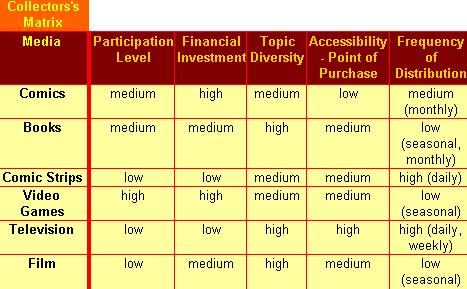Collecting Collectibles - Part Two : The Collectors' Matrix
By Hervé St-Louis
October 15, 2006 - 11:42
 |
In essence, I claim, that the more you can interact with the source of entertainment, the more likely you are to buy derivative products of said sources of entertainment. This approach differs from conventional thinking where demographics and the income (and the disposable income) of the market segment determine the success of an action figure product line. The traditional demographic / income strata are useful, but are more difficult to use in for collectors’ product line. Whereas one can claim that parents are the chief consumers of say, Barbie dolls, it’s difficult to go beyond the often repeated strata of the adult male between 25 and 45 with above average education.
That’s where the Collector’s Matrix, looking at the level of emotional investment with a property is interesting. It doesn’t to explain the origin of the motivation for interest in a property, like say the nostalgia effect. Instead of explaining the source of the motivation, it argues that the more you see it and interact with it, the more likely you will purchase a derivative product in the form of an action figure.
Why is this important? Well, if you develop action figures, you may be interested in knowing what is the likelihood that your products will be purchase by your prime target market and by the potential segment. As an action figure collector, this theory is interesting because it helps explain what drives us to buy toys!
I have segmented the media into comic books (comics), books, comic strips, video games, television and film. I used those specific media to compare how action figures created from each fair in the market.
For each category, I have looked at their participation levels, the financial investment required to consume the contents from the media. I have looked at topic diversity of the content matters of the media. I have also identified the difficulty for consumers to purchase the media at a point of purchase. Finally, I have looked that the frequency of distribution of the media. How often is it released in the market?
Table 1
 |
Participation Levels
In define participation levels as how much interaction does the consumer has with the contents of a property. I have attributed three levels of participation, high, medium and low.
Consumers with low level of participation are passive and do not control the playback, save for stopping it altogether. They do not determine any outcome of the plot. They also spend little time with the property. They are passive viewers. Most of the interaction is done in a public environment with other participants.
Consumers with medium levels of participation can interact privately with the contents. They control the playback, but cannot determine the outcome of the plot. They may spend little to lots of time immersed with the property.
Consumers with high participation levels interact with the media on a personal basis. They can stop its playback, watch it over again, “rewind” it and potentially, control the final outcome of the plot. They also spend a fair amount of time immersed in the contents.
Financial Investment
Financial investment looks at the cost of entry of the consumer who purchases a media. I have defined the financial investment as high, medium and low.
Some costs of entry are very low or purchased as part of a package. For example, getting cable television to watch say, the Sci. Fi channel may seem expensive at first. But access to the Sci. Fi channel, also gives access to other channels. Therefore, the cost of purchase is distributed on a several programming outlets. Often, there are no fees associated with exposure to the product.
Medium financial investments are defined as being from $5 to $25 yearly. One movie tickets to see a single film would be a medium cost.
High financial investments are those that necessitate more than $25 of purchase per year. Some contents, like comic books necessitate several purchases in segments within a year.
Topic Diversity
Topic diversity looks at how many genres are covered by one medium. For example, films and books are most diverse because any topic matters are covered.
Accessibility to Point of Purchase
Accessibility to the point of purchase will often determine how often the potential collector is exposed to the property. In theory, the more he can purchase this product, the more he will be involved with it, and the more he will develop an interest for derivative action figures products-based on the property. Again, I have defined access to the property as high, medium and low.
Low access means limited distribution and sources of purchases. Comic books are the best example of this. Most comic books in North America can only be purchased through comic book retailers which obtain their stock from one distributor, Diamond Comics.
Medium access means that the product can be purchased in several locations but may require some travelling. In many small towns, there may be but one store that sells video games. Some films may not be distributed to all movie theatres. Those that do may only be available for a few weeks at most.
High access means that it is relatively easy to view the contents. The only medium with such nationwide access remains television.
Frequency of distribution
 |
Low levels of distribution frequency are yearly and seasonal at best. For example, a Harry Potter novel is available at most at a frequency of one per year.
Medium levels are for products with a monthly distribution. Specific comic books series of characters as say, the X-Men are released monthly.
High levels of distribution are characteristic of products such as comic strips, published weekdays.
Now that I have defined the Collector’s Matrix, in my next article, I will look at how this model can be applied with actual product lines from each media.
